What is and what's not the Yuga Dharma
What IS the Yuga Dharma
(verses about the Yuga Dharma)
What's NOT the Yuga Dharma




Gaura premanandi hari hari bol
What IS the Yuga Dharma
To view the text on this page one requires the Balaram font installed
on one's system. One can download it for free HERE
Most of the text below is from Sri Namamrita a compilation of verses
as taught by Srila A.C. Bhaktivedanta Swami Prabhupad
Saìkértana is the
present yuga-dharma:
[Lord Caitanya to Sanätana Gosvämé]:
"...In the Kali-yuga the occupational duty of the people is to chant congregationally
the holy name of Kåñëa."
In Kali-yuga one worships Lord Kåñëa
by chanting Hare Kåñëa, Hare Kåñëa,
Kåñëa Kåñëa, Hare Hare/ Hare Räma,
Hare Räma, Räma Räma, Hare Hare. (Çré
Caitanya-caritämåta Madhya-lélä 20.339)
In the Kali-yuga, one can satisfy
and worship the Lord simply by chanting His holy name:
Çré Madhväcärya
has brought our attention to this quotation from the Näräyaëa-saàhitä:
dväparéyair janair
viñëuù
païcarätraiç tu
kevalaiù
kalau tu näma-mätreëa
püjyate bhagavän hariù
"In the Dväpara-yuga one could
satisfy Kåñëa or Viñëu only by worshiping
opulently according to the päïcarätriké system, but
in the age of Kali one can satisfy and worship the Supreme Personality
of Godhead Hari simply by chanting His holy name."
(Çré Caitanya-caritämåta
Antya-lélä 7.12)
In this age of Kali, real religious
propapada should induce people to chant the Hare Kåñëa
mahä-mantra.... Çréla Bhaktisiddhänta Sarasvaté
Öhäkura comments in this regard in his Anubhäñya,
wherein he quotes a verse from Näräyaëa-saàhitä:
The only religious principle in
the age of Kali is the chanting of the holy name:
[Éçvara Puré
to Lord Caitanya]: " 'In this age of Kali there is no other religious principle
than the chanting of the holy name, which is the essence of all Vedic hymns.
This is the purport of all scriptures.' "
(Çré Caitanya-caritämåta
Ädi-lélä 7.74)
In Kali-yuga, chanting of the
holy name is the most feasible means of salvation:
In great jubilation, Çré
Caitanya Mahäprabhu said, "My clear Svarüpa Dämodara and
Rämänanda Räya, know from Me that chanting of the holy names
is the most feasible means of salvation in this age of Kali."
(Çré Caitanya-caritämåta
Antya-lélä 20.8)
The universal religious practice
for the Kali-yuga is the chanting of the holy name:
The religious practice for the age
of Kali is to broadcast the glories of the holy name. Only for this purpose
has the Lord, in a yellow color, descended as Lord Caitanya.
In this age of Kali the practical
system of religion for everyone is the chanting of the name of Godhead.
This was introduced in this age by Lord Caitanya. Bhakti-yoga actually
begins with the chanting of the holy name, as confirmed by Madhväcärya
in his commentary on the Muëòaka Upaniñad. He quotes
this verse from the Näräyaëa-saàhitä:
dväparéyair janair viñëuù
païcarätraiç tu
kevalaiù
kalau tu näma-mätreëa
püjyate bhagavän hariù
"In the Dväpara-yuga people
should worship Lord Viñëu only by the regulative principles
of the Närada-païcarätra and other such authorized books.
In the age of Kali, however, people should simply chant the holy names
of the Supreme Personality of Godhead." (Çré Caitanya-caritämåta
Ädi-lélä 3.40)
The Çrémad-Bhägavatam
advocates näma-saìkértana as the essence of religion
in the age of Kali:
In Çrémad-Bhägavatam
it is repeatedly and clearly said that the essence of religion in the age
of Kali is the chanting of the holy name of Kåñëa.(Çré
Caitanya-caritämåta Ädi-lélä 3.50 )
Rather than inventing one's own religious
process, one should accept the approved method of religion for this age
hari-näma-saìkértana:
[Särvabhauma Bhaööäcärya
to King Pratäparudra]: Särvabhauma Bhaööäcärya
replied, "This sweet transcendental sound is a special creation of the
Lord known as prema-saìkértana, congregational chanting in
love of Godhead. In this age of Kali, Çré Caitanya Mahäprabhu
has descended to preach the religion of Kåñëa consciousness.
Therefore the chanting of the holy names of Lord Kåñëa
is the religious principle for this age. Anyone who worships Lord Caitanya
Mahäprabhu by congregational chanting should be understood to be very
intelligent. One who does not do so must be considered a victim of this
age and bereft of all intelligence."
Rascals propose that anyone can
invent his own religious process, and this proposition is condemned herein.
If one actually wants to become religious, he must take up the chanting
of the Hare Kåñëa rnahä-mantra.... Dharma, or religion,
cannot be manufactured by a human being. Religion is the law or code of
the Lord.... Dharma refers to the science of bhakti-yoga, which begins
by the novice's chanting the holy name of the Lord (tan-näma-grahaëädibhiù).
In this age of Kali it is recommended
in Caitanya-caritämåta, kali-kale dharma-kåñëa-näma-saìkértana.
In the age of Kali the chanting of the holy name of the Lord is the method
of religion approved by all Vedic scriptures. (Çré Caitanya-caritämåta
Madhya-lélä 11.97-99)
The Divine Dispensation
Apart from the holy name's importance
as a means toward individual spiritual perfection, a reading of Vaiñëava
literature reveals the holy name to possess the broadest historical and
universal significance as well. Chanting of the holy name is in fact described
as the universal and supreme religion in the current epoch, an epoch referred
to in traditional Indian texts as Kali-yuga, "the age of Kali," the great
Iron Age, an age of materialism, hypocrisy, and quarrel. Kali-yuga is the
last of the four Great Ages, each progressively worse than its predecessor,
four vast epochs that cycle perpetually. The age of Kali is the age wherein
human society degrades from human to subhuman, in which the people of the
world forget their souls, identify with their gross bodies, and become
mad competitors for the world's stock of material goods and pleasures.
As stated in Çrémad-Bhägavatam, the unfortunate inhabitants
of the Kali age are "quarrelsome, lazy, misguided, unlucky, and, above
all, always disturbed."
Because such
unfortunate persons have little or no inclination toward spiritual advancement,
there is a compelling need for a simple method by which they can wake up
from their deathly slumber and receive the opportunity for spiritual emancipation.
That Great Dispensation is the holy name. Declares Kåñëadäsa
Kaviräja Gosvämé, "In the age of Kali, Lord Kåñëa
has descended in the form of the holy name." The holy name is the one true
glory, the one saving grace of this condemned age, as Çukadeva Gosvämé
tells King Parékñit: "Although Kali-yuga is full of faults,
there is still one good quality about this age. It is that simply by chanting
the holy name of Kåñëa one can become free from material
bondage and be promoted to the transcendental kingdom."
Various means
of spiritual advancement practiced in the previous eras are rendered virtually
ineffectual in Kali by the degradation of human beings, individually and
collectively. The chanting of the holy name now supersedes all other forms
of spiritual discipline: "Whatever result was obtained in Satya-yuga by
meditating on Viñëu, in Tretä-yuga by performing sacrifices,
and in Dväpara-yuga by serving the Lord's lotus feet can also be obtained
in Kali-yuga simply by chanting the holy name of the Lord." (Çrémad-Bhägavatam
12.3.52) The primacy and exclusivity of the practice of the holy name is
emphatically declared in this oft-cited verse from the Båhan-näradéya
Puräëa: "In this age of Kali there is no alternative, there is
no alternative, there is no alternative for spiritual progress but the
holy name, the holy name, the holy name of the Lord." Thus the chanting
of the holy name of the Lord is the yuga-dharma, the universal and supreme
religion of the age, meant to unite all faiths in common, joyful glorification
of the one Supreme Lord.
Although the
chanting of the holy name has played a role in India's religious history
for millennia, it was specifically propagated and popularized as the yuga-dharma
by the great Caitanya, whose effulgent presence and fervid ecstasies drew
millions into näma-dharma, the Religion of the Name. As the great
popularizer of the holy name, Çré Caitanya was regarded and
worshiped as the Kali-yuga avatära, the prime avatära (incarnation)
for the age of Kali. Further, He was worshiped as the greatest incarnation
of the Lord because He liberally bestowed pure kåñëa-bhakti,
ecstatic love of God, upon all persons. The mahä-mantra, the chant
popularized by Çré Caitanya, is specifically mentioned in
the Kalisantaraëa Upaniñad as the exclusive means for escaping
the debilitating conditions of the Kali age: "Hare Kåñëa,
Hare Kåñëa, Kåñëa Kåñëa,
Hare Hare/ Hare Räma, Hare Räma, Räma Räma, Hare Hare—these
sixteen names composed of thirty-two syllables are the only means to counteract
the evil effects of Kali-yuga. In all the Vedas it is seen that to cross
the ocean of nescience there is no alternative to the chanting of the holy
name." Not only does the holy name bestow the highest benefits upon human
beings both individually and collectively, but it purifies even lower species
of life. Any living being fortunate enough to hear the divine, transcendental
sound incarnation of the Lord receives immense spiritual benefit.
Çré
Caitanya did not intend the holy name to remain confined to India, but
predicted that the holy name would reach "every town and village." Four
centuries later, this missionary ideal, based upon a compelling vision
of the universality of the holy name, gained momentum through the efforts
of Çréla Bhaktivinoda Öhäkura, a great follower
and ninth-generation disciplic representative of Çré Caitanya.
Writing in his religious journal Sajjana-toñané in 1885,
he declared prophetically,
Lord Caitanya did not advent
Himself to liberate only a few men in India. Rather, His main objective
was to emancipate all living entities of all countries throughout the entire
universe and preach the Eternal Religion.... There is no doubt that this
unquestionable order will come to pass.... Very soon the unparalleled path
of hari-näma-saìkértana will be propagated all over
the world.... Oh, for that day when the fortunate English, French, Russian,
German, and American people will take up banners, mådaìgas,
and karatälas and raise kértana through their streets and towns!
When will that day come? ... That day will witness the holy transcendental
ecstasy of the Vaiñëava dharma to be the only dharma, and all
the sects and religions will flow like rivers into the ocean of Vaiñëava
dharma. When will that day come?
Eighty years later, His Divine Grace
A.C. Bhaktivedanta Swami Prabhupäda, a disciple of Bhaktivinoda's
son (Bhaktisiddhänta Sarasvaté Gosvämé), left India
and traveled to the United States to transform Bhaktivinoda's dream into
reality. In 1966 he founded the International Society for Krishna Consciousness,
which, for its active propagation of the mahä-mantra, came to be popularly
known as "the Hare Kåñëa movement." The chanting and
propagation
of the holy name are the stated basis and goal of the movement. The Society's
founder, Çréla Prabhupäda, writes, "Çré
Caitanya Mahäprabhu introduced the congregational chanting of the
Hare Kåñëa mantra to give everyone a chance to hear Kåñëa's
holy name, for simply by hearing Ithe holy name] one becomes purified.
Therefore our Kåñëa consciousness movement is chiefly
engaged in chanting the Hare Kåñëa mantra all over the
world." "The Kåñëa consciousness movement," he says,
"is based on this principle: chant the Hare Kåñëa mantra
at every moment, as much as possible, both inside and outside of the temple."
This movement "is especially meant for creating an atmosphere in which
people can take to the chanting of the Hare Kåñëa mantra."
The public chanting of the holy name performed by Çréla Prabhupäda's
followers, clad in traditional Indian dhotés and särés,
is now a familiar sight on the streets of most major cities of the world.
The holy name of Kåñëa,
for so long concealed within India, locked away from Western view, has
now entered the mainstream of Western society. It has become, so to speak,
a "household mantra," available to everyone. But although it is in open,
public view, the holy name is not an ordinary commodity one can find and
purchase in the market. It is a hidden treasure. One must develop the eyes
to see it or, rather, the ears to hear it. If one simply approaches the
holy name with reverence and allows the holy name to enter through his
ears into his heart, and especially if he accepts the divine name as his
very life and soul, he can enter the deepest, most profound, most sublime
of all spiritual mysteries. (Sri Namamrita, Introduction. Srila A. C. Bhaktivedanta
Swami Prabhupad.)
Hare Kåñëa,
Hare Kåñëa
Kåñëa Kåñëa,
Hare Hare
Hare Räma, Hare Räma
Räma Räma, Hare Hare
yuga-dharma pravartäimu näma-saìkértana
cäri bhäva-bhakti diyä
näcämu bhuvana
SYNONYMS
yuga-dharma—the religion of the
age; pravartäimu—I shall inaugurate; näma-saìkértana—chanting
of the holy name; cäri—four; bhäva—of the moods; bhakti—devotion;
diyä—giving; näcämu—I shall cause to dance; bhuvana—the
world.
TRANSLATION
“I shall personally inaugurate the
religion of the age—näma-saìkértana, the congregational
chanting of the holy name. I shall make the world dance in ecstasy, realizing
the four mellows of loving devotional service." (Sri Chaitanya Charitamritam
Adi-lila 3:19.)
äpani karimu bhakta-bhäva
aìgékäre
äpani äcari’ bhakti çikhäimu
sabäre
SYNONYMS
äpani—personally; karimu—I
shall make; bhakta-bhäva—the position of a devotee; aìgékäre—acceptance;
äpani—personally; äcari’—practicing; bhakti—devotional service;
çikhäimu—I shall teach; sabäre—to all.
TRANSLATION
“I shall accept the role of a devotee,
and I shall teach devotional service by practicing it Myself."
PURPORT
When one associates with a pure
devotee, he becomes so elevated that he does not aspire even for särñöi,
särüpya, sämépya or sälokya, because he feels
that such liberation is a kind of sense gratification. Pure devotees do
not ask anything from the Lord for their personal benefit. Even if offered
personal benefits, pure devotees do not accept them, because their only
desire is to satisfy the Supreme Personality of Godhead by transcendental
loving service. No one but the Lord Himself can teach this highest form
of devotional service. Therefore, when the Lord took the place of the incarnation
of Kali-yuga to spread the glories of chanting Hare Kåñëa—the
system of worship recommended in this age—He also distributed the process
of devotional service performed on the platform of transcendental spontaneous
love. To teach the highest principles of spiritual life, the Lord Himself
appeared as a devotee in the form of Lord Caitanya. (Srila A.C. Bhaktivedanta
Swami Prabhupad. Sri Chaitanya Charitamritam Adi-lila 3:20., purport.)
äpane nä kaile dharma çikhäna
nä yäya
ei ta’ siddhänta gétä-bhägavate
gäya
SYNONYMS
äpane—personally; nä kaile—if
not practiced; dharma—religion; çikhäna—the teaching; nä
yäya—does not advance; ei—this; ta’—certainly; siddhänta—conclusion;
gétä—in the Bhagavad-gétä; bhägavate—in Çrémad-Bhägavatam;
gäya—they sing.
TRANSLATION
“Unless one practices devotional
service himself, he cannot teach it to others. This conclusion is indeed
confirmed throughout the Gétä and Bhägavatam." (Sri Chaitanya
Charitamritam Adi-lila 3:21.)
yadä yadä hi dharmasya
glänir bhavati bhärata
abhyutthänam adharmasya
tadätmänaà såjämy
aham
SYNONYMS
yadä yadä—whenever; hi—certainly;
dharmasya—of religious principles; gläniù—decrease; bhavati—there
is; bhärata—O descendant of Bharata; abhyutthänam—increase; adharmasya—of
irreligion; tadä—then; ätmänam—Myself; såjämi—manifest;
aham—I.
TRANSLATION
“‘Whenever and wherever there is
a decline in religious practice, O descendant of Bharata, and a predominant
rise of irreligion—at that time I descend Myself." (Sri Chaitanya Charitamritam
Adi-lila 3:22.)
pariträëäya sädhünäà
vinäçäya ca duñkåtäm
dharma-saàsthäpanärthäya
sambhavämi yuge yuge
SYNONYMS
pariträëäya—for the
deliverance; sädhünäm—of the devotees; vinäçäya—for
the destruction; ca—and; duñkåtäm—of the miscreants;
dharma—religious principles; saàsthäpana-arthäya—for the
purpose of establishing; sambhavämi—I appear; yuge yuge—in every age.
TRANSLATION
“‘To deliver the pious and to annihilate
the miscreants, as well as to reestablish the principles of religion, I
Myself appear, millennium after millennium.’" (Sri Chaitanya Charitamritam
Adi-lila 3:23.)
PURPORT
Texts 22 and 23 were spoken by Lord
Kåñëa in the Bhagavad-gétä (4.7–8). Texts
24 and 25, which follow, are also from the Bhagavad-gétä (3.24,
3.21). (Srila A.C. Bhaktivedanta Swami Prabhupad. Sri Chaitanya Charitamritam
Adi-lila 3:23., purport.)
utsédeyur ime lokä
na kuryäà karma ced
aham
saìkarasya ca kartä
syäm
upahanyäm imäù
prajäù
SYNONYMS
utsédeyuù—would fall
into ruin; ime—these; lokäù—worlds; na kuryäm—did not
perform; karma—action; cet—if; aham—I; saìkarasya—of unwanted population;
ca—and; kartä—the creator; syäm—would become; upahanyäm—would
spoil; imäù—these; prajäù—living entities.
TRANSLATION
“‘If I did not show the proper principles
of religion, all these worlds would fall into ruin. I would be the cause
of unwanted population and would spoil all these living beings.’" (Sri
Chaitanya Charitamritam Adi-lila 3:24.)
yad yad äcarati çreñöhas
tat tad evetaro janaù
sa yat pramäëaà
kurute
lokas tad anuvartate
SYNONYMS
yat yat—however; äcarati—behaves;
çreñöhaù—the best man; tat tat—that; eva—certainly;
itaraù—the lesser; janaù—man; saù—he; yat—which; pramäëam—standard;
kurute—shows; lokaù—the people; tat—that; anuvartate—follow.
TRANSLATION
“‘Whatever actions a great man performs,
common people follow. And whatever standards he sets by exemplary acts,
all the world pursues.’ " (Sri Chaitanya Charitamritam Adi-lila 3:25.)
Srimad Bhagavatam 1:1:10. purport
says The people in this age are very short-lived and slow in understanding
spiritual life. Actually, human life is meant for understaëding spiritual
values, but because everyone in this age is a çüdra, no one
is interested. People have forgotten life's real purpose. The word manda
means both slow and bad, and everyone in this age is either bad or slow
or a combination of both. People are unfortunate and disturbed by so many
things. According to Çrémad-Bhägavatam there will eventually
be no rain and consequently a scarcity of food. The governments will also
levy very heavy taxes. The characteristics of this age predicted by Çrémad-Bhägavatam
are already being experienced to some degree. Since Kali-yuga is a very
miserable age, Caitanya Mahäprabhu, who is Çré Kåñëa
Himself, advises everyone simply to chant Hare Kåñëa.
harer näma harer näma
harer nämaiva kevalam
kalau nästy eva nästy
eva
nästy eva gatir anyathä
[Chaitanya Charitamrita. Ädi
17.21]
"In this age of Kali there is no
alternative, there is no alternative, there is no alternative for spiritual
progress than the holy name, the holy name, the holy name of the Lord."
(Båhan-näradéya Puräëa)
This process is not Caitanya Mahäprabhu's
invention, but is advised by the çästras, the Puräëas.
The process for this Kali-yuga is very simple. One need only chant the
Hare Kåñëa mahä-mantra.(Teachings of Lord Kapila,
the Son of Devahüti)
Although God has given us all facilities
to live peacefully on this earth, cultivate Kåñëa consciousness,
and finally to come to Him, in this age we're unfortunate. We are short-lived,
and there are so many people without food, shelter, married life or defense
from the onslaughts of nature. This is due to the influence of this age
of Kali. Therefore Lord Caitanya Mahäprabhu, seeing the dreadful situation
in this age, emphasized the absolute necessity for cultivating spiritual
life. And how should we do it? Caitanya Mahäprabhu gives the formula:
harer näma harer näma
harer nämaiva kevalam
kalau nästy eva nästy
eva
nästy eva gatir anyathä
[Chaitanya Charitamrita. Ädi
17.21]
"Just always chant Hare Kåñëa."
Never mind whether you are in a factory or in hell, in a shack or in a
skyscraper—it doesn't matter. Just go on chanting Hare Kåñëa,
Hare Kåñëa, Kåñëa Kåñëa,
Hare Hare/ Hare Räma, Hare Räma, Räma Räma, Hare Hare.
There is no expense, there is no impediment, there is no caste, there is
no creed, there is no color—anyone can do it. Just chant and hear. (On
the Way to Kåñëa)
Everywhere in this age of iron everything
is degraded, degraded in this sense: prayeëälpäyuñaù
sabhya kaläv asmin yuge janäù [Srimad Bhagavatam
1.1.10]. In this age of Kali the duration of life is diminished, and men
are not moved to understand self-realization, and if they are, they are
invariably misled by so many deceitful leaders. The age is very corrupt.
Therefore Caitanya Mahäprabhu's process of chanting Hare Kåñëa
is the best and the simplest method.
harer näma harer näma
harer nämaiva kevalam
kalau nästy eva nästy
eva
nästy eva gatir anyathä
[Chaitanya Charitamrita. Ädi
17.21]
"In this age of Kali there is no
other religion than glorifying the Lord by utterance of His holy name,
and that is the injunction of all the revealed scriptures. There is no
other way, there is no other way, there is no other way."
This verse appears in the
Båhan-näradéya Puräëa. Harer näma harer
näma harer nämaiva kevalam. Simply chant Hare Kåñëa.
There is no other alternative. Kalau nästy eva nästy eva nästy
eva gatir anyathä. In this age of Kali, there is no other alternative
for self-realization. So we have to accept it.
There is another similar verse in
the Çrémad-Bhägavatam. In the Twelfth Canto, Third Chapter
(12.3.51), Parékñit Mahäräja was informed by Çukadeva
Gosvämé of the faults of this age, and now all the symptoms
of the age of Kali are apparent. In the conclusive portion, however, Çukadeva
Gosvämé said, kaler doña-nidhe räjann asti hy eko
mahän guëaù: "My dear king, this age, Kali, is full of
faulty things, but there is one good opportunity." What is that? Kértanäd
eva kåñëasya mukta-saìgaù paraà
vrajet: "Simply by chanting this Hare Kåñëa mantra one
can become liberated and go back to Godhead." (The Science of Self-Realization)
The lack of religious principles
in Kali-yuga is more than compensated by the process of chanting the holy
name:
It is said that this age of Kali
is three-fourths devoid of religious principles. Hardly one-fourth of the
principles of religion are still observed in this age. But by the mercy
of Lord Kåñëa, this vacancy of Kali-yuga has not only
been completely filled, but the religious process has been made so easy
that simply by rendering transcendental loving service unto Lord Kåñëa
by chanting His holy names, Hare Kåñëa, Hare Kåñëa,
Kåñëa Kåñëa, Hare Hare/ Hare Räma,
Hare Räma, Räma Räma, Hare Hare, one can achieve the highest
result of religion, namely, being transferred to the highest planet within
the spiritual world, Goloka Våndävana.
(Kåñëa, the Supreme
Personality of Godhead)
Chanting of the holy names
of the Lord is the common platform for the universal religion of mankind
in the Kali-yuga:
In this present age quarrels take
place even over trifles, and therefore the çästras have recommended
for this age a common platform for realization, namely chanting the holy
names of the Lord. People can hold meetings to glorify the Lord in their
respective languages and with melodious songs, and if such perfommances
are executed in an offenseless manner, it is certain that the participants
will gradually attain spiritual perfection without having to undergo more
rigorous methods. At such meetings everyone, the learned and the foolish,
the rich and the poor, the Hindus and the Muslims, the Englishmen and the
Indians, and the caëòälas and the brähmaëas,
can all hear the transcendental sounds and thus cleanse the dust of material
association from the mirror of the heart. To confirm the Lord's mission,
all the people of the world will accept the holy name of the Lord as the
common platform for the universal religion of mankind. (Çrémad-Bhägavatam
1, Intro.)
In the age of logic, argument
and disagreement, the chanting of Hare Kåñëa is the only
means of self-realization:
In three out of the four millenniums
(namely Satya-yuga, Tretä-yuga and Dväpara-yuga) people had the
honor to be able to understand transcendence through the path of disciplic
succession. However, in the present age, people have no interest in the
disciplic succession. Instead, they have invented many paths of logic and
argument. This individual attempt to understand the supreme transcendence
(called the ascending process) is not approved by the Vedas. The Absolute
Truth must descend from the absolute platform. He is not to be understood
by the ascending process. The holy name of the Lord—Hare Kåñëa,
Hare Kåñëa, Kåñëa Kåñëa,
Hare Hare/ Hare Räma, Hare Räma, Räma Räma, Hare Hare—is
a transcendental vibration because it comes from the transcendental platform,
the supreme abode of Kåñëa. Because there is no difference
between Kåñëa and His name, the holy name of Kåñëa
is as pure, perfect and liberated as Kåñëa Himself. Academic
scholars have no entrance by means of logic and other argument into the
understanding of the transcendental nature of the holy name of God. The
single path in understanding the transcendental nature of Hare Kåñëa,
Hare Kåñëa, Kåñëa Kåñëa,
Hare Hare/ Hare Räma, Hare Räma, Räma Räma, Hare Hare
is the chanting of these names with faith and adherence. Such chanting
will release one from designated conditions arising from the gross and
subtle bodies.
In this age of
logic, argument and disagreement, the chanting of Hare Kåñëa
is the only means for self-realization.(Teachings of Lord Caitanya)
The Hare Kåñëa
mantra is especially suited to deliver us from the dangers of the Kali-yuga:
Only the dvijas (the brähmaëas)
and the devas (the demigods) can be delivered from material existence by
the instructions of the Supreme Personality of Godhead. Whatever is spoken
by the Supreme Personality of Godhead is a mantra and is suitable for delivering
the conditioned souls from mental speculation. The conditioned souls are
engaged in a struggle for existence (manaù ñañöhänéndriyäëi
prakåti-sthäni karñati [Bg. 15.7]). Deliverance from
this struggle constitutes the highest benefit, but unless one gets a mantra
from the Supreme Personality of Godhead, deliverance is impossible. The
beginning mantra is the Gäyatré mantra. Therefore, after purification,
when one is qualified to become a brähmaëa (dvija), he is offered
the Gäyatré mantra. Simply by chanting the Gäyatré
mantra, one can be delivered. This mantra, however, is suitable only for
the brähmaëas and demigods. In Kali-yuga, we are all in a very
difficult position, in which we need a suitable mantra that can deliver
us from the dangers of this age. Therefore the Supreme Personality of Godhead,
in His incarnation as Lord Caitanya, gives us the Hare Kåñëa
mantra.... In His Çikñäñöaka, Lord Caitanya
says, paraà vijayate çré-kåñëa-saìkértanam:
"All glories to the chanting of çré-kåñëa-saìkértana!"
The mahä-mantra—Hare Kåñëa, Hare Kåñëa,
Kåñëa Kåñëa, Hare Hare/ Hare Räma,
Hare Räma, Räma Räma, Hare Hare—is directly chanted by the
Lord Himself, who gives us this mantra for deliverance.
We cannot invent
any means to be delivered from the dangers of material existence.... Sparks
are beautiful as long as they are in the fire. Similarly, we have to remain
in the association of the Supreme Personality of Godhead and always engage
in devotional service, for then we shall always be brilliant and illuminating.
As soon as we fall from the service of the Lord, our brilliance and illumination
will immediately be extinguished, or at least stopped for some time. When
we living entities, who are like sparks of the original fire, the Supreme
Lord, fall into a material condition, we must take the mantra from the
Supreme Personality of Godhead as it is offered by Çré Caitanya
Mahäprabhu. By chanting this Hare Kåñëa mantra,
we shall be delivered from all the difficulties of this material world.
(Çrémad-Bhägavatam 8.6.15, Bhaktivedanta purort.)
The above text was used courtesy
of http://www.vedabase.com/
used
with permission
See our
Harernama pages

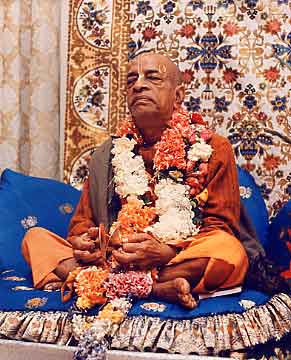
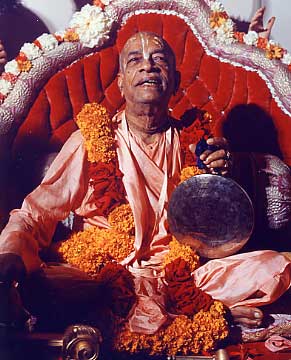
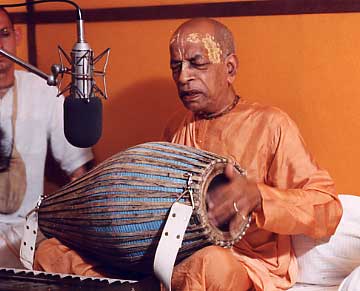
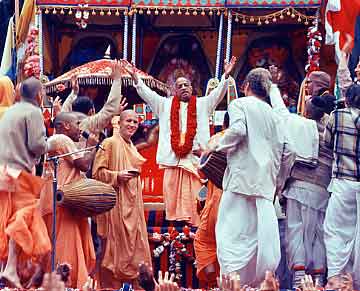
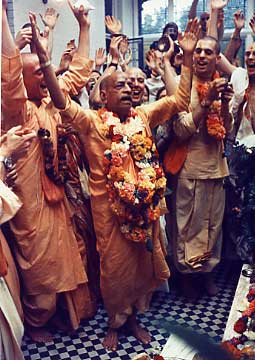
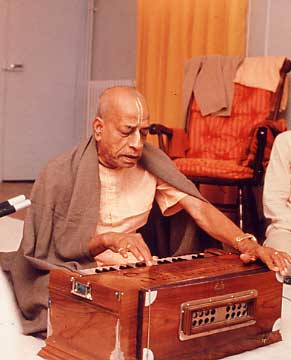
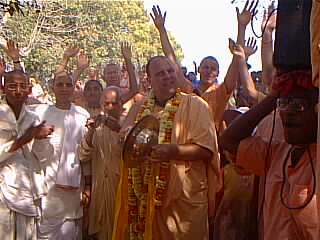

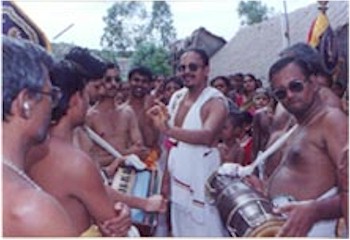
@
Madhurai South India
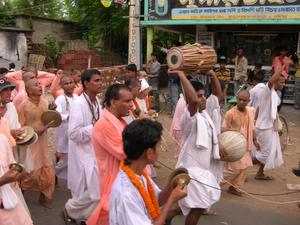
In
Mayapur West Bengal
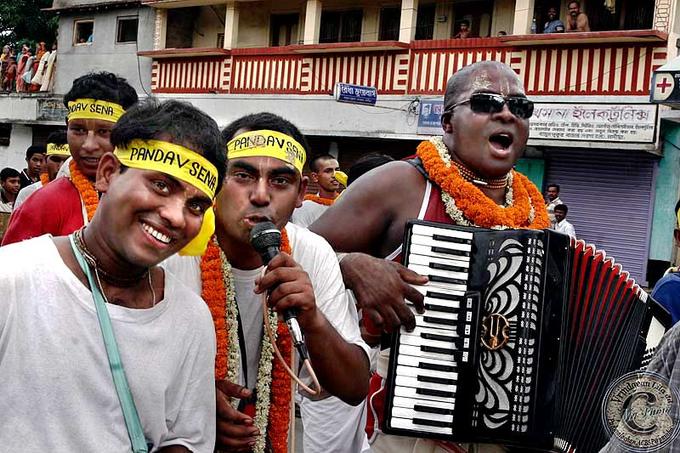
Pandav
Sen Youth forum devotees in Mayapur

little
kids chanting
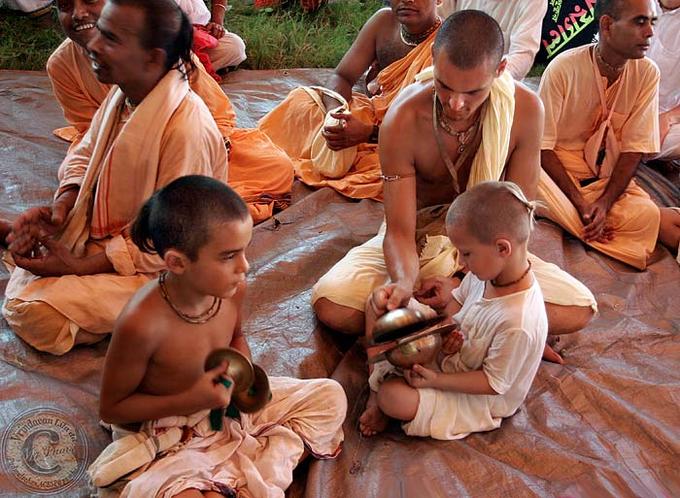

Elderly women chanting

Young
women chanting





There are no material limitations to the Holy Names of
the Lord,
or who can hear or chant them 
Nectar KIRTAN


Click here
to hear the Holy Name
What is NOT the means for achieving Love of God
- The Yuga Dharma
Sarva-dharmän means we have
created so many dharmas. That is not dharma; that is... Dharma, we
generally become so-called religious for artha, for money. Dharma-artha.
Artha, money, is required. Why? For sense gratification, käma. And
when we are dissatisfied, then we want mokña. Therefore, we are
actually busy with four kinds of activities: Dharma-artha-käma-mokña
[Srimad Bhagavatam 4.8.41, Chaitanya Charitamrita. Ädi-lila 1.90].
And above these, when we go above these, then bhakti begins. That is the
beginning of bhakti. That wanted. (Srila A.C. Bhaktivedanta Swami Prabhupad,
Srimad Bhagavatam 3:25:44, lecture excerpt. 12th December 1974, Bombay)
According to Bhagavad Gita 17:17
there are different modes under which people perform different austerities
or penence to attain the results thereof:
çraddhayä parayä
taptaà
tapas tat tri-vidhaà naraiù
aphaläkäìkñibhir
yuktaiù
sättvikaà paricakñate
SYNONYMS
çraddhayä—with faith;
parayä—transcendental; taptam—executed; tapaù—austerity; tat—that;
tri-vidham—of three kinds; naraiù—by men; aphala-äkäìkñibhiù—who
are without desires for fruits; yuktaiù—engaged; sättvikam—in
the mode of goodness; paricakñate—is called.
TRANSLATION
This threefold austerity, performed
with transcendental faith by men not expecting material benefits but engaged
only for the sake of the Supreme, is called austerity in goodness.
Bg 17.18
TEXT 18
satkära-mäna-püjärthaà
tapo dambhena caiva yat
kriyate tad iha proktaà
räjasaà calam adhruvam
SYNONYMS
sat-kära—respect; mäna—honor;
püjä—and worship; artham—for the sake of; tapaù—austerity;
dambhena—with pride; ca—also; eva—certainly; yat—which; kriyate—is performed;
tat—that; iha—in this world; proktam—is said; räjasam—in the mode
of passion; calam—flickering; adhruvam—temporary.
TRANSLATION
Penance performed out of pride and
for the sake of gaining respect, honor and worship is said to be in the
mode of passion. It is neither stable nor permanent.
PURPORT
Sometimes penance and austerity
are executed to attract people and receive honor, respect and worship from
others. Persons in the mode of passion arrange to be worshiped by subordinates
and let them wash their feet and offer riches. Such arrangements artificially
made by the performance of penances are considered to be in the mode of
passion. The results are temporary; they can be continued for some time,
but they are not permanent.
Bg 17.19
TEXT 19
müòha-gräheëätmano
yat
péòayä kriyate
tapaù
parasyotsädanärthaà
vä
tat tämasam udähåtam
SYNONYMS
müòha—foolish; gräheëa—with
endeavor; ätmanaù—of one's own self; yat—which; péòayä—by
torture; kriyate—is performed; tapaù—penance; parasya—to others;
utsädana-artham—for the sake of causing annihilation; vä—or;
tat—that; tämasam—in the mode of darkness; udähåtam—is
said to be.
TRANSLATION
Penance performed out of foolishness,
with self-torture or to destroy or injure others, is said to be in the
mode of ignorance.
PURPORT
There are instances of foolish penance
undertaken by demons like Hiraëyakaçipu, who performed austere
penances to become immortal and kill the demigods. He prayed to Brahmä
for such things, but ultimately he was killed by the Supreme Personality
of Godhead. To undergo penances for something which is impossible is certainly
in the mode of ignorance.
You decide where the following slot
in
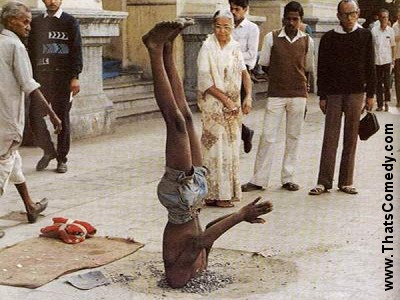
I wonder how long the others will stand there and watch????
what is the bigger austerity, participating or watching
NEITHER are the Yuga Dhama, that's the point.

certainly some perform austerities to control the mind and body, like
sitting surrounded by "five fires" (four of cow-dung and one the blazing
sun overhead)
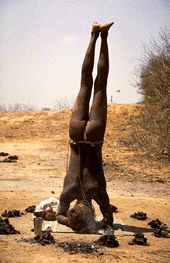
or doing continuous head stand surrounded by five fires all day

Bajrang Baba - never sits down, he stands by day and night and has done
for many years
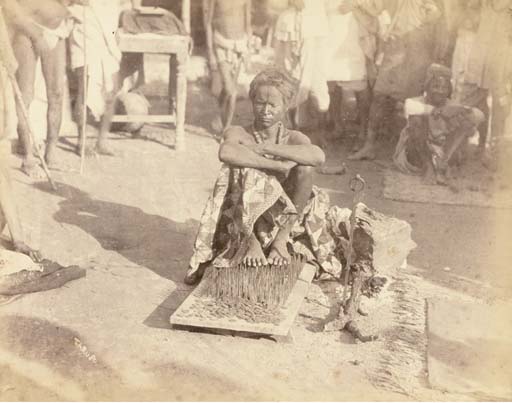
a sadhu sitting on a bed of nails
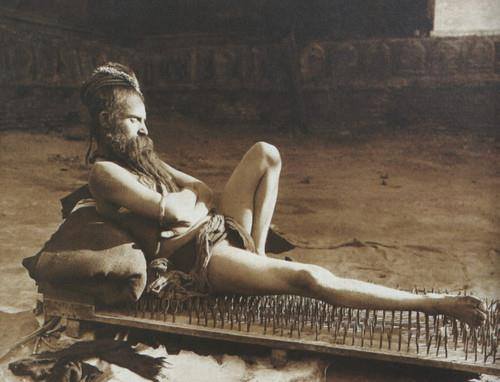
a pain in the bottom......but not the yuga dharma
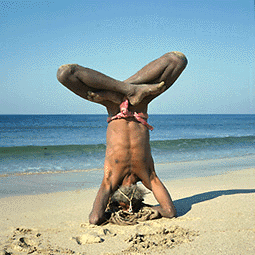
er what about a variation of the head stands in sun...........
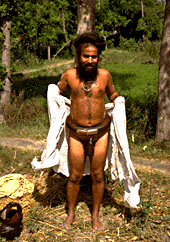
or what about wearing of the chastity belt
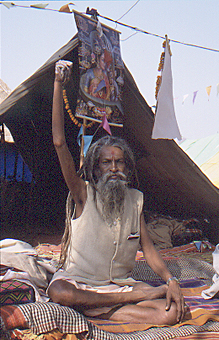
Amar Bharati Baba who keeps one arm raised his entire life as an austerity
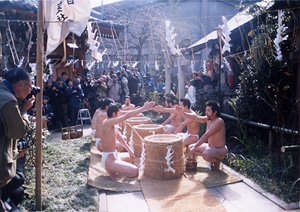
what about bathing in cold waters in the cold, certainly austere
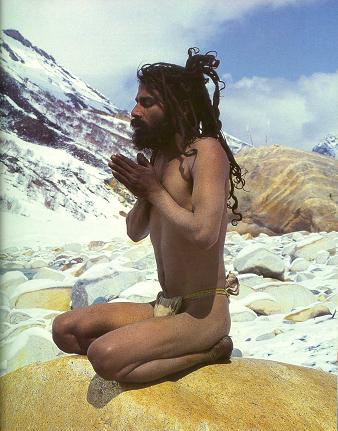
Brrrrrrrrrrrrrrr........going naked in the snow of the Himalayas
but it isn't the recomended process for self realization in the Kali
Yuga (the yuga dharma)

er okay.........na not that either
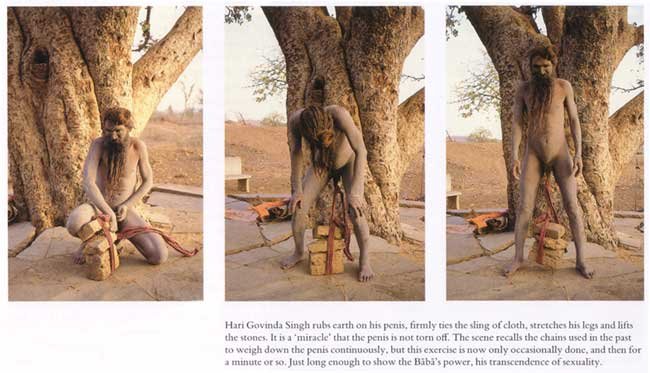
I'm not even going to comment..............
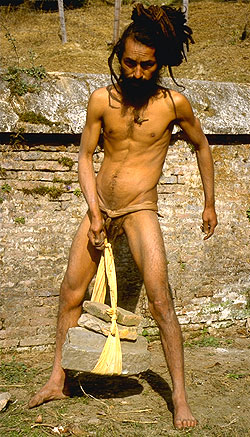
seems like a popular austerity - here's another one

I'm really glad this is not the yuga dharma too
not by any s-t-r-e-t-c-h of the imagination is this the yuga dharma
who teaches these people this stuff????

I think his name is Pearce - they say he did this while waiting for
someone to tell him what is the yuga dharma


keep it together dude

smile......we've got the yuga dharma

Holy nose holes......

none of your lip mate........use them in the service of the yuga dharma

well he thinks he knows, and he thinks he knows......

a key man..........
but not the key to the yuga dharma
yuga dharma ki jaya

eeeek na not the Yuga Dharma

"May there be good fortune throughout the universe, and may all envious
persons be pacified.
May all living entities become calm by practicing bhakti-yoga, for
by accepting devotional service
they will think of each other's welfare. Therefore let us all engage
in the service of the supreme transcendence,
Lord Sri Krishna, and always remain absorbed in thought of Him." (Srimad
Bhagavatam 5:18:9.)

in the time it would have taken him to put on all these he could have
chanted hare krishna and participated in the Yuga Dharma
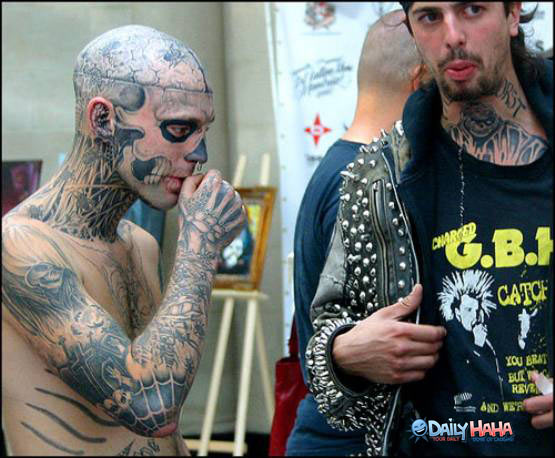
negative to the bone

not even close hahahaha

hmmmmmmmm

iteresting tilak.....

a colourful character - but its not the yuga dharma


say argh..................ARGHHHHH
still waiting..........no direction
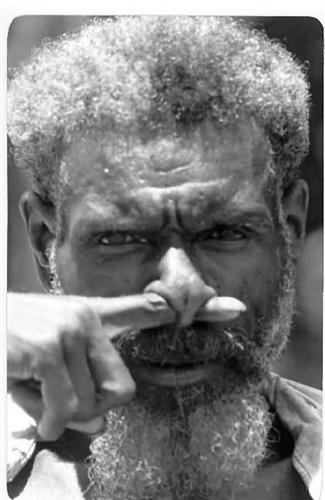
must be someone over there performing the yuga dharma........follow
that pointing finger

at least you wont lose yer pen while trying to find what is the yuga
dharma
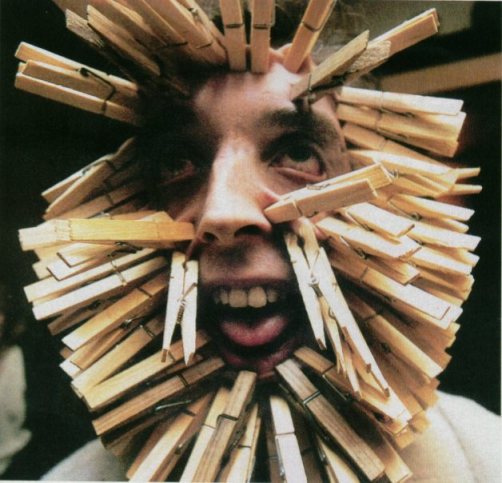
not at a pinch is this the yuga dharma..........

er thank you - NEXT

400 cans of coke balanced on his head............and still not the process
for God realization (the yuga dharma) sorry NOT THE REAL THING

she used to be a nice girl
she only has to ask what is the yuga dharma and we can tell her, would
save so much trouble and discomfort
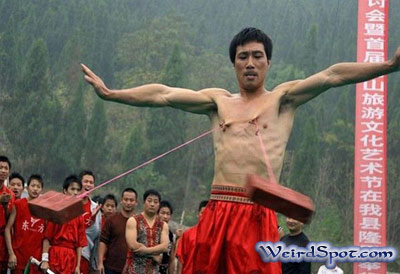
talking of which............each to his own
could make the congregational sharing of the yuga dharma very interesting,
if it was the yuga dharma, which its NOT

Bees
nah sorry not even close, this is not the yuga dharma....be off with
you

careful in a crowd please.......don't turn round quickly
oooooooops

a-n-y-w-a-y, ........this was not the yuga dharma either

check mate
na you've lost it mate.....
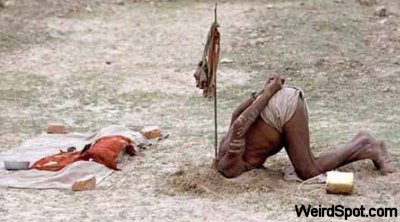
where's the yuga dharma???
is it down there????
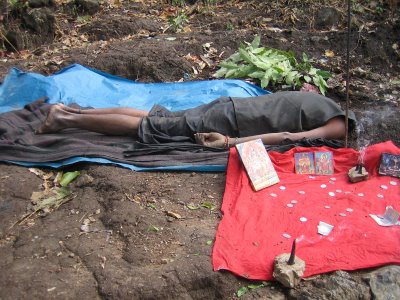
I know I said that mere shows of devotion don't touch the surface, but
there's no need to bury your head under the surface to find the Yuga Dharma

please enlighten me as to what is the yuga dharma

........call me when you find the yuga dharma
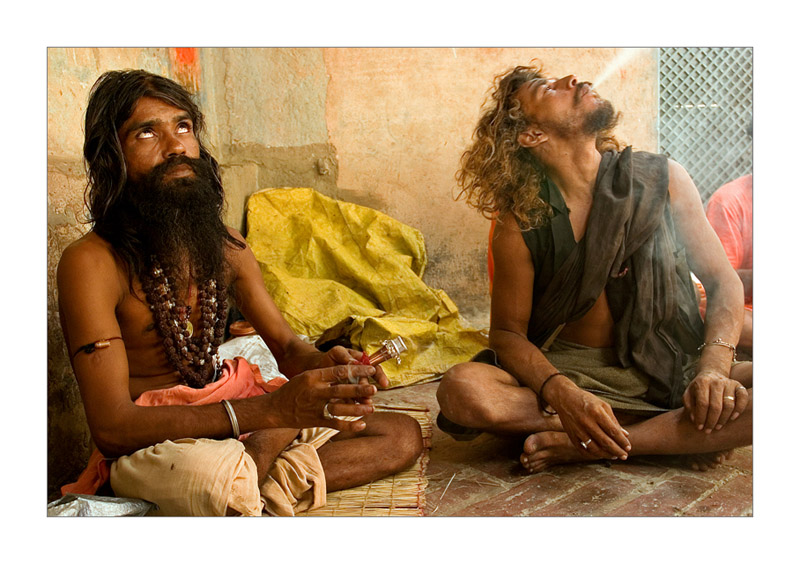
woooooaaaaaah man - where's the yuga dharma????

naga babas sitting naked covered in ash and smoking chillum pipes of
charak or ganja (cannibis)
........and you are right, this is not the yuga dharma either
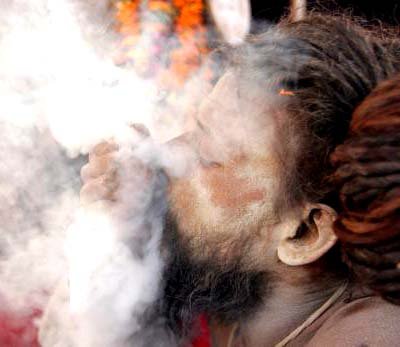
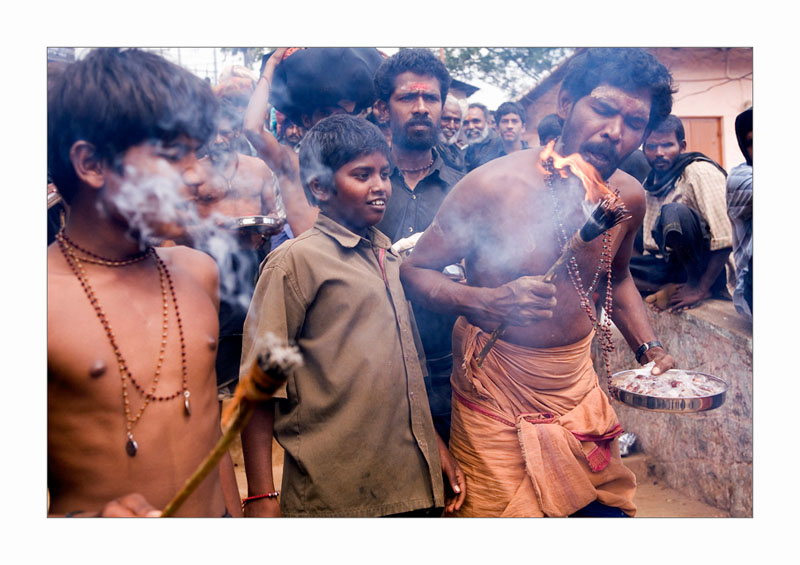
.......nor is fire eating
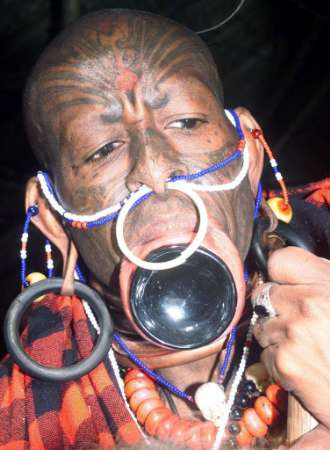
dude....come on, what have you been doing, the yuga dharma is much more
simple and less painful than that.

okey dokey.......nah still not the yuga dharma
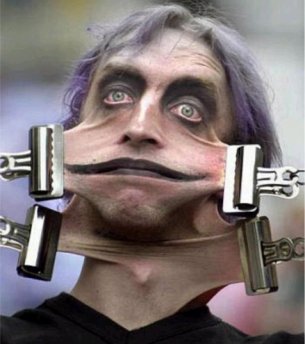
this is not the yuga dharma by any stretch of the imagination

nah even though one could breath clearly through the nose, and mouth,
this is not yuga dharma

hooked on you maybe, but it still doesn't catch the yuga dharma

this identifies him as a warrior in his tribe, but it still isn't
the yuga dharma

she got "round to it" many round toits........but didn't receive the
nectar of the yuga dharma.

......and for what benefit is he hanging around?
its certainly not the yuga dharma

a tall order for sure - really not the yuga dharma
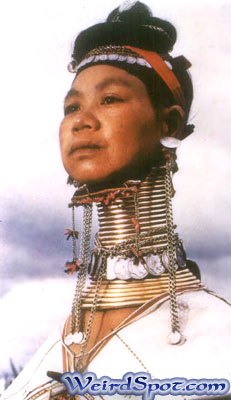
its not honestly

no matter how many do it, its not the yuga dharma

wow
also not the yuga dharma
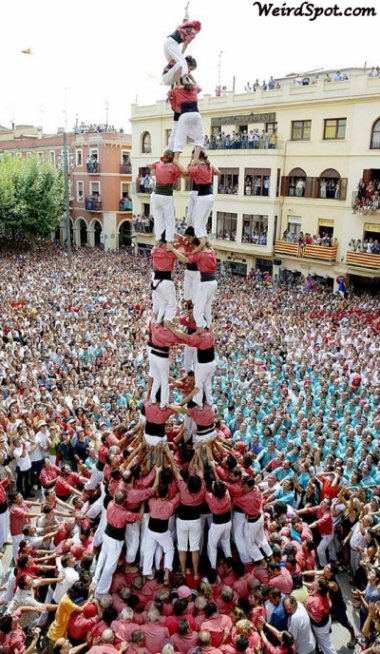
yes yes they did it...............and for what??? .........its not the
yuga dharma
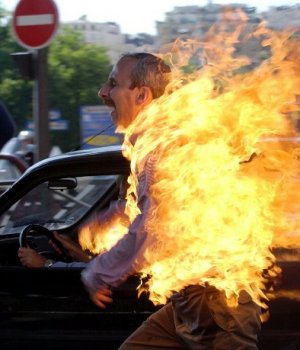
This Iranian man set himself on fire for a political statement !!!
He might be fired up, but it isn't the yuga dharma

the yuga dharma will spread like wild fire in every town and village,
but this is not the process, hahaha or even a symptom

what would a month down in that hole say to you???
........imagine everyone all over the world practicing this as the yuga
dharma
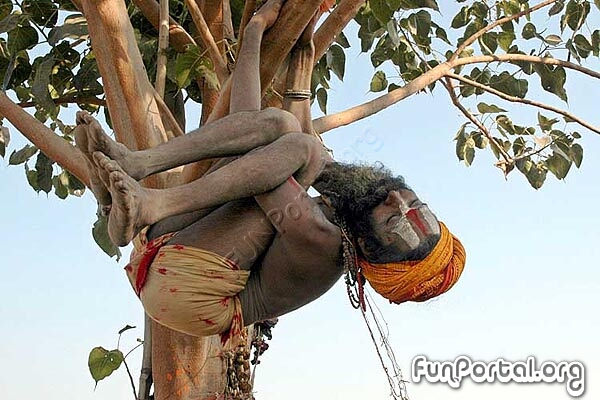
hang in there baba
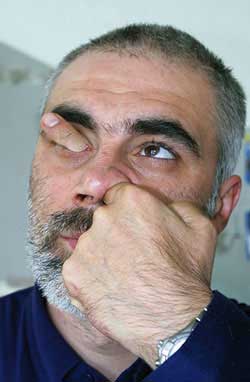
ooops got something in my eye - its my finger
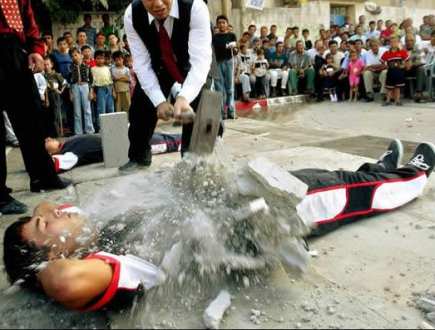
call me later, you are breaking up !!!

a boring day at the office

totally stitched up

man you have way too much spare time on his hands

Hiranyakashipu did something like it for 120,000 years

and this proves what exactly???

er okay.....you know the drill
but where's the yuga dharma???

I'm getting rid of my office chair

good on a hot day - but not the yuga dharma

Weight watchers or Jenny Craig??? Try our new weightloss program

naaa sorry the Yuga Dharma is more practical than this

............and the purpose being????
imagine if this were the yuga dharma and everyone doing this all day
every day, world wide

.................there must have been an accomplice

for some it would be beneficial

na that's not the Yuga Dharma either despite it being congregational
and cleansing to some degree......

wouldn't your mother be proud of you.....
....but not for knowing the Yuga Dharma
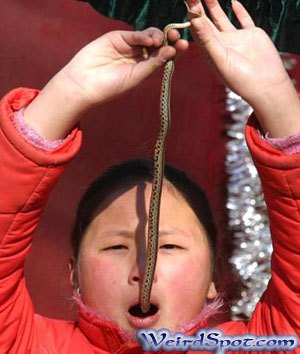
Holy snakes alive

Yoga - in the losest of terms maybe - meditation on the third eye maybe.......

yes well what can one say??? see you in a few hours
still NOT the yuga dharma

he's seen the light, shame he didn't find the yuga dharma

and here we see Ravi standing, maybe looking for the yuga dharma...........
Some
more sadhus HERE
and hundreds of other difficult austerities, too many to feature
here
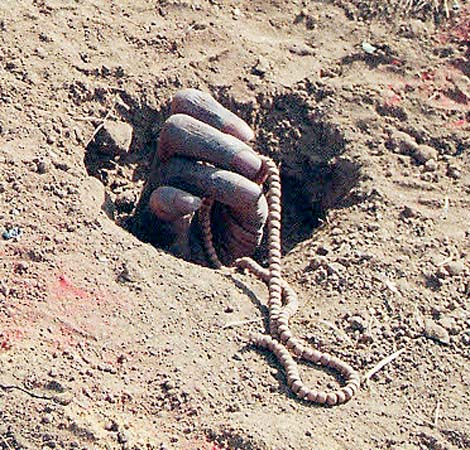
no need to bury yourself......

making an offering - right - but still this is not the yuga dharma.....come
on be practical 

....the old world meets the modern world of ipods and AK47s, but neither
met the Yuga Dharma
........if you know of any, you can send them in

BUT for those who actually want to find the Yuga Dharma
Please Click
HERE

Copyright ©2005 The Bhaktivedanta Book Trust
International, on the web at http://www.krishna.com.
Used with permission.

All original content is licensed under a Creative
Commons Attribution-ShareAlike 2.5 License.





![]()

















































































































